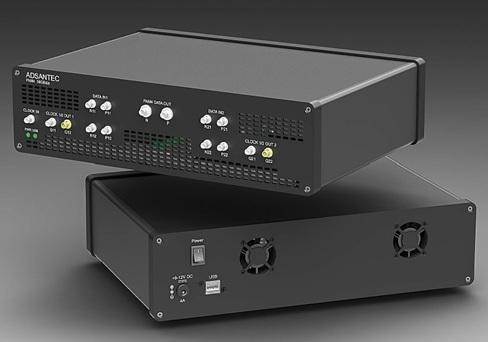Product Details

Figure 1. Functional Block Diagram
The ADSANTEC’s differential PAM4 generator unit can be used for test applications, design verification, and R&D environments. The fully self-sustained device is integrated in a box with power conditioning, control circuitry, and a USB computer interface. All signal I/O’s are CML-type. The front panel of the instrument is shown in Fig. 1 (top). It includes two differential 1.85mm outputs for PAM4 Data Output, a single-ended 2.92mm clock input connector, eight 2.92mm connectors for four differential data input channels, and four SMA connectors providing half-rate clock output. The back panel of the instrument contains a power switch (Power), a power supply female connector (+9-12V DC) for connecting a male 2.5×5.5 barrel jack from an external AC-DC adapter, and a USB-B connector (USB) for connecting an external PC with installed Windows GUI control software.
The system consists of four main parts: Frequency Synthesizer, two high-speed 2:1 Multiplexers, two high-speed differential PAM4 combiners, and a Power Supply unit. The Frequency Synthesizer generates internal clock signals that are used by other parts of the system. The two incoming pairs of PRBS signals are processed by two 2:1 MUXes to produce two PRBS signals with doubled data rate. The MUXes also provide the clocks required for the Four-Channel external PRBS Generator. The clock phases may be individually adjusted in each MUX2:1 module via the system’s USB control interface. The output signals from 2:1 MUXes are mixed in two PAM4 combiners to form a differential PAM4 signal. The output amplitude of this signal may be adjusted. The amplitude of the middle eye opening can be individually adjusted without affecting the top and bottom eye opening amplitudes. Alternatively, the system may be programmed to output high-speed PRBS data instead of PAM4 data through the same I/Os. All the parameters of this PAM4 Generator are controlled by an external PC through a USB port. A special GUI software is installed on the PC to simplify the system control.
